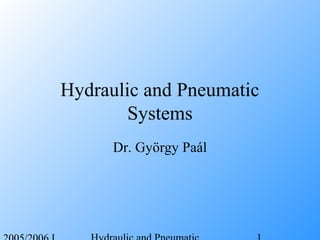This document discusses hydraulic and pneumatic systems. It provides details on hydrostatic and hydrodynamic power transmission. Hydrostatic transmission allows for continuous variation and is commonly used for linear movement against large forces or exact positioning. The document outlines typical hydraulic system components like pumps, valves, actuators. Advantages are discussed such as creating large forces and compact design. Fluid properties like viscosity and types of hydraulic fluids are also summarized. The document concludes with basics of hydraulic calculations involving flow resistance, pressure transmission, and continuity equations.



![Hydrostatic vs hydrodynamic systems
Roughly speaking:
P = ∆p·Q
Large Q, small ∆p →
hydrodynamic
transmission
Large ∆p, small Q →
hydrostatic transmission.
But there is no general rule,
depends on the task.
o Generally larger than 300 kW power hydrodynamic is more favourable.
o But for soft operation (starting of large masses) hydrodynamic is used for
smaller powers either.
Linear movement against large forces: hydrostatic
Linear movement and stopping in exact position: also hydrostatic
Power density
kW
kg
P [kW]100 200 300 400
Hydrostat.
Hydrodyn.](https://image.slidesharecdn.com/hpsi-181104191017/85/Hps-i-4-320.jpg)













![Properties of hydraulic fluids
Viscosity: well-known
Temperature dependence
Ubbelohde-Walther:
c, m, Kv are constants,
T is in K
TmKc v lg))lg(lg( ⋅−=+ν
ct
B
t eA +
⋅=µ
ν
t [°C or K]
⇒ log-log scale
Vogel-Cameron:
A, B, C are constants,
t is in °C](https://image.slidesharecdn.com/hpsi-181104191017/85/Hps-i-18-320.jpg)
![Properties of hydraulic fluids (contd.)
Pressure dependence
of viscosity
µ0, ν0 viscosity at
atmospheric pressure
p
p eα
µµ ⋅= 0
100 200 300 400
1,5
2
2,5
3
0ν
ν
p [bar]
30 °C
40 °C
50 °C
T=80 °C](https://image.slidesharecdn.com/hpsi-181104191017/85/Hps-i-19-320.jpg)




























![Hydraulic Systems
Viscosity over temperature
Temperature [C°]
Viscosity[mm2
/s]](https://image.slidesharecdn.com/hpsi-181104191017/85/Hps-i-48-320.jpg)










